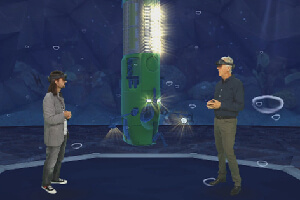Why Black Opal Is So Expensive
Narrator: High-quality black opal can cost over $10,000 per carat, making it one of the world’s most expensive gemstones. But mining black opal isn’t easy. After investing tens of thousands of dollars, a miner might not find a single gem. So, what makes black opal so hard to find? And why is it so expensive?
Black opal is one of the most enchanting stones in the world, sought after for its seemingly infinite display of colors. Compared to common opal, which is usually one color, black opal exhibits many different colors contrasted by a dark body tone.
Frederick Mallouk: It’s simply the most stunning gemstone on the planet. It’s just remarkably beautiful. You can put the thing away for a week, pick it out and look at it, and you can still see things inside it that you’ve never, ever seen before.
Narrator: Opal is found in several parts of the world, including Ethiopia, Brazil, and Mexico. But over 90% of the world’s opal comes from Australia. And a lot of the black opal is found here, at Lightning Ridge. It’s located on the edge of the Outback, with a population of just over 2,000 people. Miners have been searching for opal here for over 100 years. But even for experts, finding black opal isn’t easy.
Frederick Mallouk: If you were to start mining tomorrow, and once you learn mining skills – and I’ve been mining for 40 years – we’d be an equal chance, just because there’s nothing really that can tell you, “Oh, there is opal in that piece of ground” or “There’s not opal in that piece of ground.”
Narrator: Miners start by drilling a vertical shaft in an area that they think contains opal. Then they must clear out an underground room large enough to start digging at the rock.
Frederick Mallouk: The basic idea of mining is basically extract[ing] the opal clay out from the ground, put it onto a truck, I take the truck to a puddling site in town, and check if there’s opal in that.
Narrator: The equipment needed to mine and the cost to register your claim can be extremely expensive.
Frederick Mallouk: Really, if you wanted to rock up here and be serious, it’d probably...need $150,000 to $100,000 in your pocket to have a go.
Narrator: But buying the equipment doesn’t guarantee that miners will find black opal.
Frederick Mallouk: Some people will go, “Oh, there’s definitely money there, because next door, they got $200,000 and there was a bit of color drilled up here. It’s got to have come over.” And there’s a whole epic story of why there should be opal there, and you go and dig there, and it’s not.
Narrator: Miners search for areas in the rock with trace amounts of opal. They follow these spots, called “nobbies,” hoping to find more opal deeper in the rock.
Frederick Mallouk: You’ll keep going in a straight line till the trace runs out, and then come back where there was trace in the wall, go left and right, and then if that stops, then you come back and do it again. And you can come back and do it again. So you’ve always got that in the back of your head, you know, “When do I leave, how long do I stay, have I stayed too long? I’m wasting time, I’m wasting money for my next patch.” There’s a nobby there.
When you’re in a really good pocket, see how these nobbies are sitting close like that together? They can be like a cluster, like a bunch of grapes. They’re all sitting around each other, and they’ve all got color. Hear that?
See that sound? It’s like glass. So you get that big one out, there we go. Doesn’t have any value. Common black opal.
Narrator: Opal is formed when silica-rich groundwater hardens in rock over millions of years. Large silica spheres within the stone diffract light, creating vibrant colors. That play of color makes each gem unique. But for miners like Frederick, digging for black opal is a gamble.
Frederick Mallouk: The human factor is the biggest factor in finding opal. If you’ve got a piggy bank of $10,000 or $20,000 and then, all of a sudden, in one month or two months, you’ve blown all of that budget because you’ve had breakdowns and you’ve had things occur that you didn’t think of, and then you go, “Well, I’m $20,000 down. What do I do here?” I’ve been full-time mining for about over 45 years, and quite often, I say to myself, “How did you do it? How did you survive that long making it your only job?” I’ve done...I’ve done good. Not great. I haven’t been in the millions. I haven’t been up there in the…in the fantasy pocket, you know?
Narrator: Once rough opal is extracted and processed from the dirt, it has to be cut and polished. This is when the real value of the gem is determined.
Jo Lindsay: A black opal can vary from...starting at maybe $1,000 a carat for run of your mill and going right up to tens of thousands of dollars for…for that really exquisite top quality. The main stone is 241 carats. A few thousand dollars a carat wouldn’t be unreasonable. A lot of money.
Narrator: The color, brightness, and patterns can all influence the price of black opal.
Jo Lindsay: What you’re looking for in the best-quality opal is a black stone with really bright color and as much red and other colors as possible. So the most valuable black opal of all is a really bright red stone on a very black base that just glows. And you don’t see them very often at all.
Narrator: That lack of supply is a huge driver for the price of black opal.
Jo Lindsay: We can barely keep up with the demand at the moment. As soon as you find a gem-quality stone, you know you’ve got a buyer for it.
Narrator: Between 2005 and 2006, approximately $30 million of opal was mined at Lightning Ridge. And for fans of black opal, there’s simply nothing else like it.
Jo Lindsay: It’s just a magic stone, and when I came to Lightning Ridge, just the beauty of it captivated me.
Frederick Mallouk: It’s an awesome job. I would love to find two or three more good claims, like, one more good patch, get rid of the debts that we have, and set it up and offer the opportunity for my son to take over the job.














